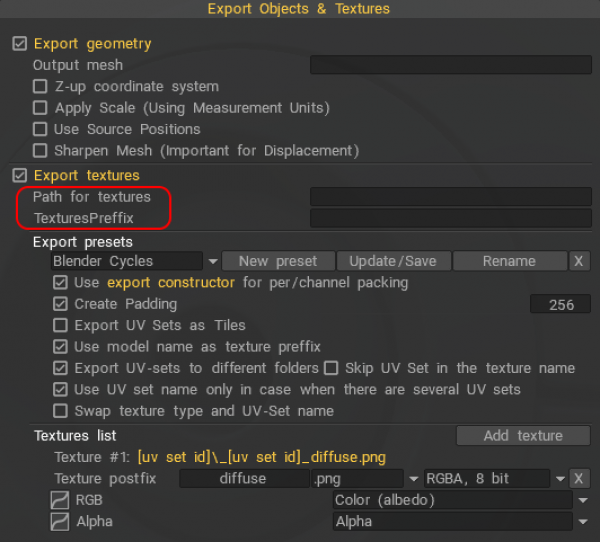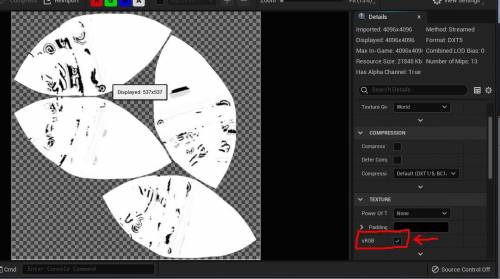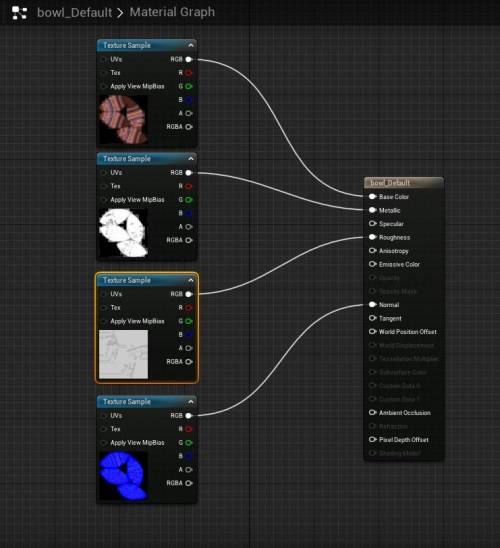Υπάρχουν μόνο δύο κατηγορίες export που μπορούν να πραγματοποιηθούν ενώ εργάζεστε στον χώρο εργασίας Painting :
1. Export του πολυγωνικού μοντέλου όπως ορίζεται στο Retopo Workspace.
2. Export όλες τις ζωγραφισμένες υφές που δημιουργήθηκαν στον χώρο εργασίας Painting .
Χωρίς UVs δεν υπάρχουν υφές για export.
Μια διάταξη UV καθορίζει τον τρόπο με τον οποίο μια εικόνα 2D ή ένας χάρτης υφής τυλίγεται σε μια τρισδιάστατη επιφάνεια.
Οι UVs συνήθως γίνονται απαραίτητες μόνο όταν αρχίζετε να ζωγραφίζετε υφές ή θέλετε να bake κανονικούς χάρτες.
Όλα τα Δεδομένα Painting Υφής περιέχονται στα διάφορα επίπεδα που έχουν δημιουργηθεί στο Χώρο εργασίας Painting .
Αυτά τα δεδομένα υπάρχουν με τη μορφή των πέντε βασικών Χαρτών UV που δημιουργούνται την ίδια στιγμή που ζωγραφίζετε αυτές τις πληροφορίες στο γλυπτό σας.
Όπως συμβαίνει κατά την εξαγωγή δεδομένων από τον χώρο εργασίας UV , πρέπει να τεθούν σε μια μορφή που κατανοούν οι άλλες εφαρμογές.
Αυτή η μορφή είναι αυτή ενός χάρτη UV . Ξεχωριστοί χάρτες αποθηκεύονται για καθεμία από τις πέντε κατηγορίες υφής που έχετε δημιουργήσει ζωγραφίζοντας στο μοντέλο σας:
Διάχυτο χρώμα, Χρώμα γυαλάδας, Ένταση εκπομπής, κανονικές πληροφορίες (εξόγκωμα) και πληροφορίες μετατόπισης.

Ενεργοποιήστε την εντολή Export κατασκευαστή για να δείτε προεπιλογές export
Εξαγωγή χάρτη μετατόπισης Ένα βίντεο βήμα προς βήμα που δείχνει πώς να εισάγετε ένα αντικείμενο χαμηλής πολυ UV και να διαμορφώσετε πρόσθετες λεπτομέρειες σε αυτό, στη συνέχεια πώς να bake έναν displacement map και να τον προβάλετε στο μοντέλο low poly της Industry Tuts.
Η μετατόπιση εξάγεται χρησιμοποιώντας τη διαφορά μεταξύ της θέσης μιας κορυφής και της θέσης της στο στρώμα 0.
Οι θέσεις κορυφών θα λαμβάνονται από το Επίπεδο 0. Αυτή είναι η προτιμώμενη επιλογή για export χαμηλού πολυ .
Η μετατόπιση βασίζεται πάντα στο Layer 0. Αλλά οι θέσεις των κορυφών στο εξαγόμενο αρχείο OBJ εξαρτώνται από την επιλογή σας. Είναι καλύτερο να χρησιμοποιείτε τέτοιους συνδυασμούς πλαισίων ελέγχου export :
– σετ 1:
[x] Χρησιμοποιήστε θέσεις πηγής
[ ] Επιλέξτε θέσεις από το Layer0
[ ] Τραχύς…
Χρησιμοποιήστε το εάν το στρώμα 0 δεν είναι παραμορφωμένο.
– σετ 2:
[ ] Χρησιμοποιήστε θέσεις πηγής
[x] Επιλέξτε θέσεις από το Layer0
[x] Χονδρό…
Χρησιμοποιήστε το εάν το στρώμα 0 είναι παραμορφωμένο. Η επιλογή από το επίπεδο 0 θα αποθηκεύσει νέες θέσεις, το χοντρό θα το προετοιμάσει για περαιτέρω υποδιαίρεση.
Αλλά αν το στρώμα Χ δεν παραμορφωνόταν κανονικά, η απλή export μετατόπισης δεν θα βοηθούσε. Πρέπει να ψήσετε ξανά το πλέγμα για να αποκτήσετε κανονική μετατόπιση ή να χρησιμοποιήσετε διανυσματική μετατόπιση.
Παράδειγμα Export σε Unreal από την Digman
Ρύθμιση 3DC: – Η τραχύτητα/μεταλλικότητα επιλέγεται στο μενού υφών.
– Προβολή μενού. GGX Burley 12 (Unreal4).
– Μενού Αρχείο— Export αντικειμένων και υφών—- Πίνακας Export Unreal5
(Unreal 4.27 ή 5.) Επιλέξτε τα αρχεία fbx και texture για import. Ο normal map θα εισαχθεί σωστά από την Unreal. Δεν χρειάζεται δουλειά.
Η μεταλλικότητα και η τραχύτητα εισάγονται ως SRGB. Ανοίξτε το πρόγραμμα επεξεργασίας εικόνας για κάθε εικόνα και αποεπιλέξτε το Srgb. Αποθηκεύστε την εικόνα. Τώρα θα είναι γραμμικοί χάρτες και θα αποδίδονται σωστά. Θα παρατίθενται ως γραμμικά στο πρόγραμμα επεξεργασίας υλικού.
Θα πρέπει να έχετε ήδη δημιουργήσει ένα προεπιλεγμένο υλικό—Κάντε διπλό κλικ πάνω του για να ανοίξει.
Σύρετε όλα τα αρχεία υφής στο default_material editor και εισάγετέ τα στις σωστές υποδοχές.
Κάντε αίτηση και αποθηκεύστε.
Τελευταία φωτογραφία: Φυσικά, ο φωτισμός είναι διαφορετικός σε αυτή την απλή ρύθμιση. Τα χρώματα είναι σωστά και η μεταλλικότητα και η τραχύτητα ταιριάζουν πολύ με το 3DC. Το PBR αντιδρά, όπως γνωρίζετε σωστά σε διαφορετικές ρυθμίσεις φωτισμού, επομένως ο φωτισμός είναι διαφορετικός στην εξωπραγματική σκηνή και στο 3DC.



 Ελληνικά
Ελληνικά  English
English Українська
Українська Español
Español Deutsch
Deutsch Français
Français 日本語
日本語 Русский
Русский 한국어
한국어 Polski
Polski 中文 (中国)
中文 (中国) Português
Português Italiano
Italiano Suomi
Suomi Svenska
Svenska 中文 (台灣)
中文 (台灣) Dansk
Dansk Slovenčina
Slovenčina Türkçe
Türkçe Nederlands
Nederlands Magyar
Magyar ไทย
ไทย हिन्दी
हिन्दी Tiếng Việt
Tiếng Việt Lietuviškai
Lietuviškai Latviešu valoda
Latviešu valoda Eesti
Eesti Čeština
Čeština Română
Română Norsk Bokmål
Norsk Bokmål